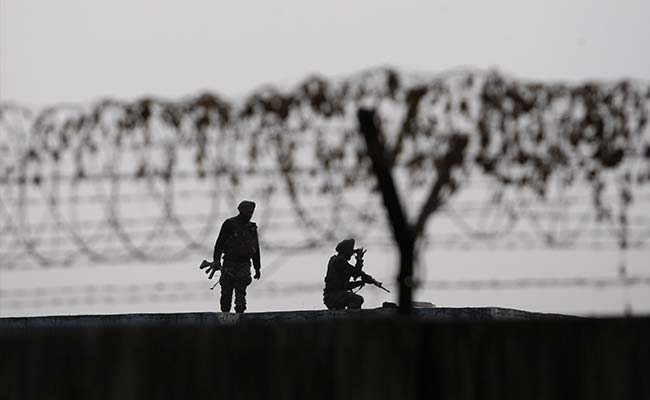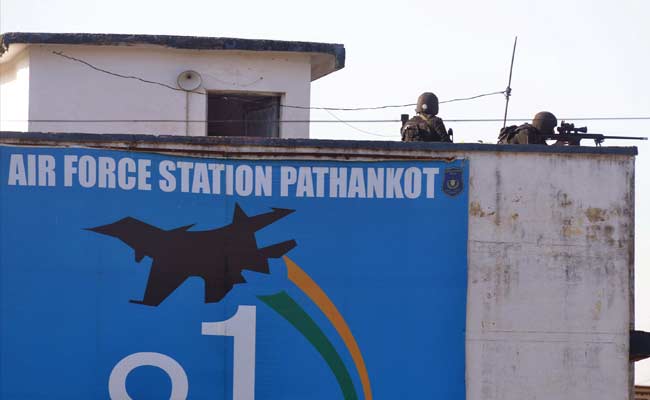Seven military personnel were martyred and 20 others were injured in the attack by six terrorists at the Pathankot air base.
New Delhi:
How the six Pakistani terrorists divided among themselves the deadly task of attacking the Pathankot air force base earlier this month has now been reconstructed by experts from the military, who have shared their findings exclusively with NDTV.
Their report - submitted to the government recently - concludes that two of the terrorists were assigned to act as "guides" for the other four. It was their job to lead the larger group to the technical area where fighter jets and helicopters were parked. This pair of attackers were not armed with machine guns. They had Improvised Explosive Devices or IEDs, highly flammable incendiary gels, and ammonium nitrate. The plan was to destroy as many high-value military assets as possible.
Seven military personnel were martyred in the attack.
The four terrorists referred to as Group 1 entered the air force base early on the morning of January 2 by scaling a 10-foot high wall topped with barbed wire. They were detected by thermal devices on surveillance aircraft only the next day, on January 3. Group 2 (the pair of gunmen) had arrived earlier on January 1 - it's still not clear how they breached the base.

The fact that the thermal devices never spotted the six men moving together confirms earlier reports that the men operated in separate teams.
As security forces responded, it was the group of four terrorists moving together that was killed first on January 2, approximately six hours after they opened fire indiscriminately in a cafeteria before moving out. Before they were shot dead, since they were unable to move either to the technical area where aircraft are parked, or to the residential area - nearly 1,600 people live on the massive base which is 2,000 acres - the terrorists blew up several motorcycles and parked cars. A senior officer in the operation told NDTV, "The manner in which they blew up the civilian vehicles showed that they were frustrated in not being able to get into the technical area."
By now on January 3, the remaining two terrorists had taken shelter on the ground floor of a residential building. There were at least five air force officers were on the first floor; they had locked themselves into rooms and placed furniture against the doors as a bulwark. They were evacuated by commandos from the National Security Guard or NSG before security forces began the final effort to shoot the terrorists.

A total of nearly 500 commandos were used in the operation that lasted nearly 80 hours. The NSG's Lt Col Niranjan, who was killed while trying to defuse a grenade, was not wearing a bomb disposal suit. "The bomb suit weighs about 60 kg, the terrain was undulating and covered by elephant grass, it was not possible to wear the suit, Lieutenant Colonel Niranjan didn't violate any procedure. He was an expert," a senior official told NDTV.
Their report - submitted to the government recently - concludes that two of the terrorists were assigned to act as "guides" for the other four. It was their job to lead the larger group to the technical area where fighter jets and helicopters were parked. This pair of attackers were not armed with machine guns. They had Improvised Explosive Devices or IEDs, highly flammable incendiary gels, and ammonium nitrate. The plan was to destroy as many high-value military assets as possible.
Seven military personnel were martyred in the attack.
The four terrorists referred to as Group 1 entered the air force base early on the morning of January 2 by scaling a 10-foot high wall topped with barbed wire. They were detected by thermal devices on surveillance aircraft only the next day, on January 3. Group 2 (the pair of gunmen) had arrived earlier on January 1 - it's still not clear how they breached the base.

The fact that the thermal devices never spotted the six men moving together confirms earlier reports that the men operated in separate teams.
As security forces responded, it was the group of four terrorists moving together that was killed first on January 2, approximately six hours after they opened fire indiscriminately in a cafeteria before moving out. Before they were shot dead, since they were unable to move either to the technical area where aircraft are parked, or to the residential area - nearly 1,600 people live on the massive base which is 2,000 acres - the terrorists blew up several motorcycles and parked cars. A senior officer in the operation told NDTV, "The manner in which they blew up the civilian vehicles showed that they were frustrated in not being able to get into the technical area."
By now on January 3, the remaining two terrorists had taken shelter on the ground floor of a residential building. There were at least five air force officers were on the first floor; they had locked themselves into rooms and placed furniture against the doors as a bulwark. They were evacuated by commandos from the National Security Guard or NSG before security forces began the final effort to shoot the terrorists.

A total of nearly 500 commandos were used in the operation that lasted nearly 80 hours. The NSG's Lt Col Niranjan, who was killed while trying to defuse a grenade, was not wearing a bomb disposal suit. "The bomb suit weighs about 60 kg, the terrain was undulating and covered by elephant grass, it was not possible to wear the suit, Lieutenant Colonel Niranjan didn't violate any procedure. He was an expert," a senior official told NDTV.
Track Latest News Live on NDTV.com and get news updates from India and around the world

